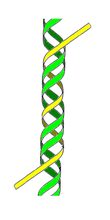Triple-stranded DNA

A triple-stranded DNA is a structure of DNA in which three oligonucleotides wind around each other and form a triple helix. In this structure, one strand binds to a B-form DNA double helix through Hoogsteen or reversed Hoogsteen hydrogen bonds.
For example, a nucleobase T binds to a Watson–Crick base-pairing of T-A by Hoogsteen hydrogen bonds between an AxT pair (x represents a Hoogsteen base pair). An N-3 protonated cytosine, represented as C+, can also form a base-triplet with a C-G pair through the Hoogsteen base-pairing of an GxC+. Thus, the triple-helical DNAs using these Hoogsteen pairings consist of two homopyrimidines and one homopurine, and the homopyrimidine third strand is parallel to the homopurine strand.
A homopurine third strand can also bind to a homopurine-homopyrimidine duplex using reversed Hoogsteen patterns. In this triplex, a nucleobase A binds to a T-A base pair and a G to a C-G pair. Since the nucleobases on the third strand have to be reversed, the homopurine third strand is antiparallel to the homopurine strand of the original duplex.
Triple-stranded DNA was a common hypothesis in the 1950s when scientists were struggling to discover DNA's true structural form. Watson and Crick (who later won the Nobel Prize for their double-helix model) originally considered a triple-helix model, as did Pauling and Corey, who published a proposal for their triple-helix model in the 1953 scientific journal Nature, as well as fellow scientist Fraser. However, Watson and Crick soon identified several problems with these models:
- Negatively charged phosphates near the axis will repel each other, leaving the question as to how the three-chain structure would stay together.
- In a triple-helix model (specifically Pauling and Corey's model), some of the van der Waals distances appear to be too small.
Fraser's model differed from Pauling and Corey's in that in his model the phosphates are on the outside and the bases are on the inside, linked together by hydrogen bonds. However, Watson and Crick found Fraser's model to be too ill-defined to comment specifically on its inadequacies in their publication in "Nature" (1953): Molecular Structure of Nucleic Acids.
Triple-stranded DNA was also described in 1957, when it was thought to occur in only one in vivo biological process: as an intermediate product during the action of the E. coli recombination enzyme RecA. Its role in that process is not understood.
Using nucleic acid segments that bind to the DNA duplexes to form triple strands as a way of regulating gene expression is under investigation by biotechnology companies. Similar work is also being undertaken at Yale University.
Triple-stranded DNA has been implicated in the regulation of several genes. One, the c-myc gene has been extensively mutated to examine the exact role that triplex DNA structure, versus linear sequence, plays in gene regulation. A c-myc promoter element, termed the nuclease-sensitive element or NSE, can form tandem intramolecular triplexes of the H-DNA type and has a repeating sequence motif (ACCCTCCCC)4. The NSE when mutated and examined for transcriptional activity and for intra- and intermolecular triplex forming ability. The transcriptional activity of mutant NSEs can be predicted by the element's ability to form H-DNA and not by repeat number, position, or the number of mutant base pairs. DNA may therefore be a dynamic participant in the transcription of the c-myc gene (Firulli et al., 1994). A DNA triplex is formed when pyrimidine or purine bases occupy the major groove of the DNA double Helix forming Hoogsteen pairs with purines of the Watson-Crick basepairs. Intermolecular triplexes are formed between triplex forming oligonucleotides (TFO) and target sequences on duplex DNA. Intramolecular triplexes are the major elements of H-DNAs, unusual DNA structures, which are formed in homopurine-homopyrimidine regions of supercoiled DNAs. TFOs are promising gene-drugs, which can be used in an anti-gene strategy, that attempt to modulate gene activity in vivo. Numerous chemical modifications of TFO are known. In peptide nucleic acid (PNA), the sugar-phosphate backbone is replaced with a protein-like backbone. PNAs form P-loops while interacting with duplex DNA forming triplex with one of DNA strands leaving the other strand displaced. Very unusual recombination or parallel triplexes, or R-DNA, have been assumed to form under RecA protein in the course of homologous recombination.
References
- Rich, Alexander (1993). "DNA comes in many forms". Gene 135 (1–2): 99–109. doi:10.1016/0378-1119(93)90054-7. PMID 8276285.
- Soyfer, Valery N.; Potaman, Vladimir N. (1995). Triple-Helical Nucleic Acids. New York: Springer. ISBN 978-0-387-94495-1.
- Mills, Martin; Arimondo, Paola B.; Lacroix, Laurent; Garestier, Thérèse; Hélène, Claude; Klump, Horst; Mergny, Jean-Louis (1999). "Energetics of strand-displacement reactions in triple helices: A spectroscopic study". Journal of Molecular Biology 291 (5): 1035–54. doi:10.1006/jmbi.1999.3014. PMID 10518941.
- Watson, J. D.; Crick, F. H. C. (1953). "Molecular Structure of Nucleic Acids: A Structure for Deoxyribose Nucleic Acid". Nature 171 (4356): 737–8. Bibcode:1953Natur.171..737W. doi:10.1038/171737a0. PMID 13054692.
- Firulli, A.B.; Maibenco, D.C.; Kinniburgh, A.J. (1994). "Triplex Forming Ability of a c-myc Promoter Element Predicts Promoter Strength". Archives of Biochemistry and Biophysics 310 (1): 236–42. doi:10.1006/abbi.1994.1162. PMID 8161210.